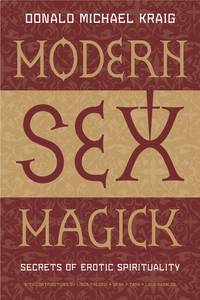Biblical Sex Magick?
Introduction
There are different ways to effectively write non-fiction books. Some people see where a book would fill a need, do a lot of research, and write a book to fill that need. You can usually tell this type of author because their books cover an amazingly wide range of topics.
I have a lot of admiration for people who choose to do this. The work they do to discover, assemble, and present the information can be invaluable. It’s just not my way.
I prefer to write books where I have a deep knowledge of the subject through personal experience and study. That’s not a better approach, it’s just my approach. It’s also one of the reasons I’m so pleased with my book, Modern Sex Magick.
Other books on sex magick, before and since, have primarily been focused on repeating the techniques that were crystallized by Aleister Crowley. His practices were based on his own experiences and the information contained within the O.T.O. before he became its leader. That information is decidedly 19th century. It’s still very practical and usable (and widely available), but has a strong focus on materialistic approaches and at times is rather sexist.
Wondering if there were something…more…something intrinsically non-sexist and not dependent upon materialistic aspects of sex magick, I spent years doing research and practicing what I learned. As you may have guessed, I enjoyed the practice!
History
In the “traditional” history of sex magick, there were a few pre-cursors to Crowley and the O.T.O. ranging from shamanic practices to the Barbelo Gnostics of thousands of years ago and to Paschal Beverly Randolph (Wikipedia notes that “Randolph is notable as perhaps the first person to introduce the principles of sex magic to North America, and, according to A.E. Waite, establishing the earliest known Rosicrucian order in the United States”), but little else. As a result of research including rare, out-of-print books and even college doctoral theses, I was able to piece together an alternate, ignored history that was more linear and based on secretive Kabalistic traditions.
In Modern Sex Magick I described how the Bible, Talmud, and other Kabalistic sources clearly revealed this information. Perhaps the information I gave about the Bible, quoted from obscure books and interpreted through the Talmud, had the least amount of clear evidence to support it. Well, the writings in the Jewish Bible, as we have it now, are at least 2,500 years old, plenty of time to cover up the inner secrets.
But not forever.
New Evidence
One of the sections I pointed out in the Bible was the clear eroticism of the Shir Ha-shireem or “Song of Songs” (sometimes wrongly called the “Song of Solomon”). This is a highly passionate love poem that seems surprisingly out of place (read my book to find out why it’s there) in a holy book. To rationalize this away, up-tight experts claim it is just a metaphor for God’s love for his people. Really? I don’t see how any intelligent person can read it and come to that conclusion.
Now, a new study indicates that I was right and the “experts” were wrong.
Here are passages from the text:
Let me kiss him with the kisses of his mouth—for thy love is better than wine.
He hath brought me to the banqueting-house, and his banner over me was love.
… refresh me with apples; for I am sick with love.
It seems to be focused on the importance of that amazing feeling/emotion, love. But, according to Anthony Pyles, formerly a Protestant seminary student in Mississippi and currently a doctoral student at McMaster Divinity College (Canada) specializing in the “Old Testament,” in a paper presented to the Congress of the Humanities and Social Sciences in Fredericton, that translation is wrong. It shouldn’t be “love,” it should be lovemaking.
The Hebrew uses ah-hah-vah, usually translated as “love.” Well, I did a bit of research on the Hebrew. It turns out that the root of the word, hah-vah, means “lust” or “desire.” That’s a far cry from the romantic concept of love and far closer to Pyles’ translation of “lovemaking.” With a different pronunciation of the same letters, hah-veh, it means “present” as in “being in the present moment.” Being present, focusing on exactly what is going on rather than having your mind somewhere else, is a valuable component of sex magick.
So it appears quite likely to me, that Pyle’s interpretation, based on a footnote he read (the source of the footnote was not given in the article) could be correct, especially when you match it to the information included in Modern Sex Magick.
Curiously, the first verse above is strangely translated. The word given in English as “love” is doh-deh-chah (the “ch” as in the gutteral German ach). This is a complete mistranslation! The word is more accurately translated as “your breasts” (or “thy breasts”). I was confused about this until I saw that a Greek translation of the Song of Songs had this translation, too. So this is clearly about physicality, not about romantic love.
Conclusion
Although I would like to read Mr. Pyle’s complete paper, I would contend that from his limited perspective he is probably correct. This would add an entirely new aspect to the “Song of Songs,” and leads to some questions: if this poem is about sex and lovemaking, why is it included in the Bible? It could have been excluded as were so many other books collectively known as the pseudepigrapha and apocrypha. Does it have a deeper meaning warranting its inclusion in the Bible? I would contend that it does. And those secrets are in Modern Sex Magick.
Why do you think the “Song of Songs” in the Bible?











Thank you for adding the explanation about the Hebrew word. It amazes me how much the Bible can mistranslate even the most simplest of words.